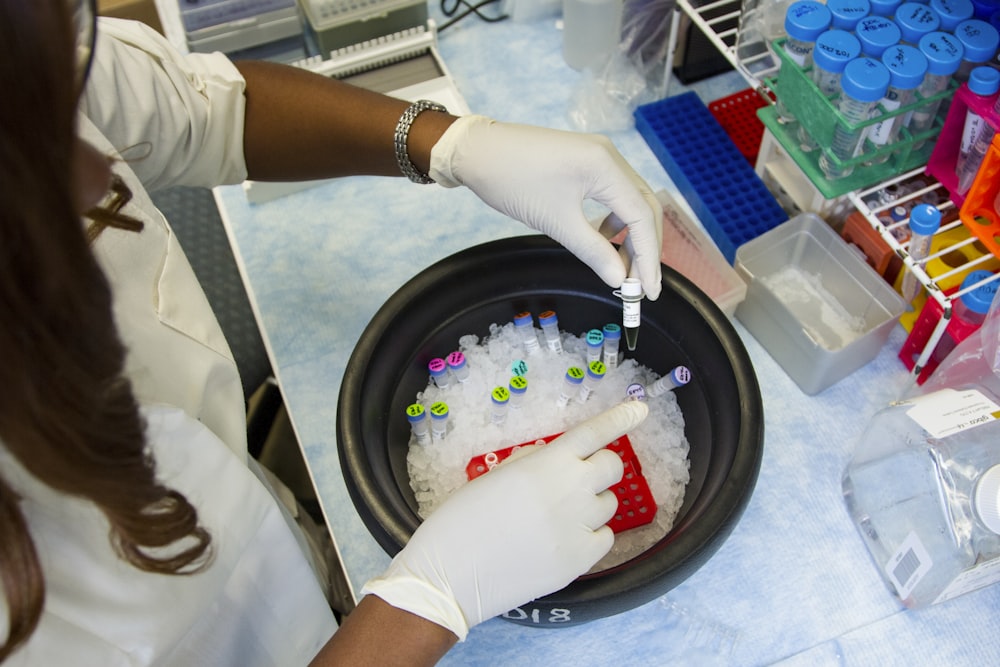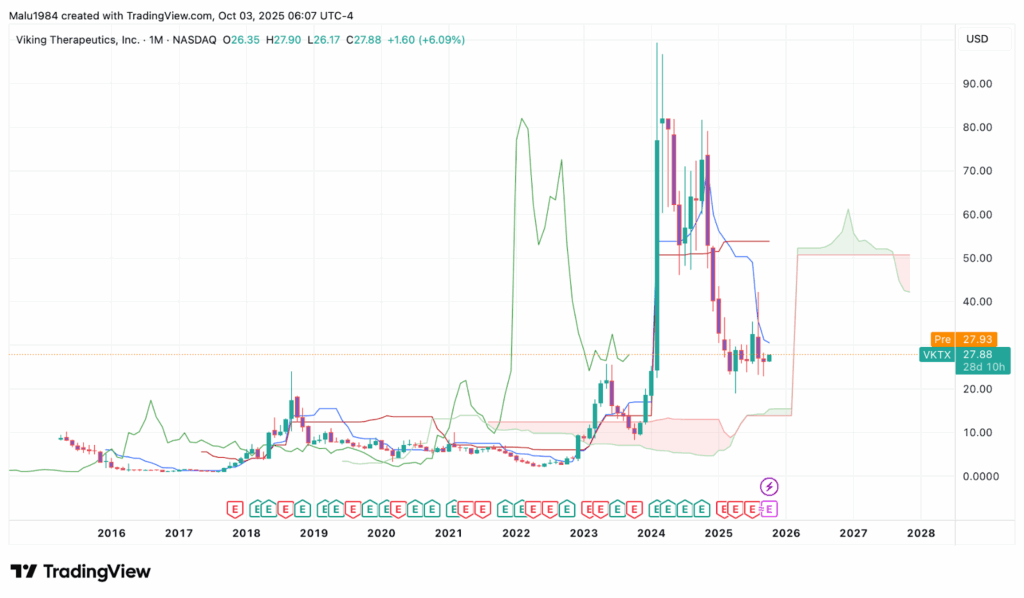Viking Therapeutics Stock: A Stumble Or The Setup Of The Decade?
Image Source: Unsplash
Viking Therapeutics is not a household name yet. But this small biotech is trying to play in the biggest money game in healthcare right now: weight loss drugs. The same field where Novo Nordisk and Eli Lilly turned into giants.
The twist? Viking is not just running one program. They have an injectable weight loss drug in Phase 3, a pill version in development, plus a liver disease drug and even rare disease assets on the side. On top of that, they locked in massive supply deals, signaling they might go solo instead of waiting for a buyout.
Wall Street is split. Some see the recent sell-off as proof Viking will struggle. Others see it as a once-in-a-decade setup if their trials hit. That makes it a perfect candidate to run through our analysis.
The IDDA analysis framework is used to analyze companies and determine which are right for you. There are five steps to the process:
- Capital analysis – Your personal risk tolerance.
- Intentional analysis – Your unique financial goals and timelines based on your age, health, and lifestyle.
- Fundamental analysis – The viability of the asset based on company performance, financial health, and market position.
- Sentimental analysis – The current emotions of Wall Street and other market participants.
- Technical analysis – Historical price action to identify key psychological levels and market patterns.
Let’s dive into the analysis to assess Viking Therapeutics stock (VKTX)’s fundamental, sentimental, and technical outlook.
IDDA Point 1&2: Capital & Intentional
The capital and intentional analysis need to be conducted by you.
Select your assets in alignment with your financial goals. Listen to your intuition about each asset, but remember to invest based on your own values, not just because of recommendations from others.
IDDA Point 3: Fundamental
Now, here are some fundamental factors to analyze.
- Cash runway: Viking ended Q2 2025 with about $808 million in cash. They have no revenue yet, but this “cash runway” (money in the bank to keep the lights on) should cover their big Phase 3 trials. This means they don’t need to rush into raising more money right now.
- Obesity program progress: Their main drug candidate, VK2735, comes in two forms: an injectable (a shot you take with a pen-like device) and an oral pill. The injectable has already started Phase 3 trials, which is the last big stage before FDA approval. The pill showed strong weight loss at 13 weeks, but many people dropped out due to stomach side effects like nausea. Management says they’re working on better dosing to fix this.
- NASH program strength: Viking also has a drug for NASH (also called MASH), which is a type of liver disease caused by fat buildup. In a long trial, the drug VK2809 hit its main goals (patients’ liver health got better) without major safety issues. This gives Viking a second chance to win in another huge market besides weight loss.
- Rare disease pipeline: They are also testing a drug for a rare disease called X-ALD (X-linked adrenoleukodystrophy). It’s a brain and nervous system disorder. Early data showed the drug lowered harmful fats in the blood. It’s still early, but this could be valuable if bigger studies confirm it.
- Manufacturing readiness: Viking signed a long-term deal with CordenPharma, a company that makes drugs at large scale. This contract locks in the ability to produce millions of injection pens, syringes, and pills per year. It helps reduce the risk of “supply crunch” if Viking’s drugs get approved.
- Industry competition: The problem? Giants like Lilly and Novo already dominate this space with Ozempic, Wegovy, and Zepbound. They also have factories running at full speed. Merck and Pfizer are entering the game, too. Viking is the underdog and must deliver excellent trial results to carve out market share.
- Market access limits: Right now Medicare, the U.S. insurance program for seniors, does not pay for obesity drugs. Only some small pilot programs exist. This means patients may have to pay out of pocket, which could slow down Viking’s sales at the start.
- Fundamental risk: Medium to high
Viking has money in the bank and more than one drug in play, which lowers the chance of total failure. But the competition is fierce, the Phase 3 trials are long, and insurance coverage is still a big unknown. That makes it riskier than average even if the upside is huge.
IDDA Point 4: Sentimental
Overall sentiment is mixed for Viking Therapeutics. Investors are torn between excitement about their progress and fear from recent stumbles.
Strengths
- Analyst support: Some Wall Street analysts still set high price targets for Viking Therapeutics, seeing the obesity and liver drugs as big market opportunities.
- Obesity buzz: Obesity drugs are the hottest story in healthcare. Every success headline about weight loss keeps attention on Viking, even if Lilly and Novo dominate now.
- Manufacturing deal: Investors like that Viking already secured massive supply capacity with CordenPharma. It signals they plan to launch on their own and not rely on a buyout. That reduces fear of “can they scale?”
- Pipeline diversity: Viking is not a one-trick pony. They have drugs in obesity, liver disease, and a rare condition. That gives investors a safety net if one program fails.
Risks
- Stock reaction to the pill: When Viking announced results for their obesity pill, the data looked good for weight loss, but many patients dropped out due to stomach side effects. The stock plunged almost 40% in a day. That shows how fast sentiment can flip.
- David vs. Goliath: Lilly and Novo are giants with billions in revenue and factories running worldwide. Viking is a small biotech with no product yet. Some investors worry they can’t compete.
- Policy questions: Right now, Medicare does not cover weight loss drugs. Only small pilot programs exist. Without broad insurance coverage, sales for the whole class could be slower than expected.
- Market nerves: Tariff headlines under Trump spooked pharma investors. Even though Viking has no commercial product yet, traders fear policy changes could raise costs later.
- Sentimental risk: High
The market is often emotional with Viking Therapeutics. Optimism spikes on progress, but fear shows up fast after any stumble. Until Viking proves itself with late-stage data, expect to see some sharp swings.
IDDA Point 5: Technical
In February 2024, Viking Therapeutics spiked and hit all-time highs at $99. After that, it formed a “double top” pattern (two failed attempts to break higher), which is often a bearish sign. The trend then reversed, dropping all the way to $19 by April 2025.
Ichimoku signals are mixed. The price candles are above the Ichimoku cloud (normally bullish), but the cloud itself is red and wide (which shows strong resistance). The conversion line (short-term trend line) is below the baseline (longer-term trend line), which is bearish.
Viking Therapeutics Monthly Stock Chart
(Click on image to enlarge)
On the weekly chart, the Ichimoku signals lean bearish. Price candles are below the cloud, and the cloud is red. That means the cloud is acting as a ceiling, blocking upward moves.
The conversion line is slightly above the baseline, which gives a small bullish signal, but it is not strong enough to change the bigger trend yet. The RSI (a momentum indicator) is at 46, which is in neutral territory. This means the stock is not overbought (too expensive) or oversold (too cheap).
If the stock breaks above $42, a key psychological level, such a move could open the door for higher targets.
Viking Therapeutics Weekly Stock Chart
(Click on image to enlarge)
Buyers could consider purchasing the stock at the recent market price or at these buy limit levels:
- $20.77 – High risk
- $13.09 – Moderate risk
- $9.26 – Low risk
Investors looking to take profit can also consider these sell limit levels:
- $49.78 (Short-term)
- $57.45 (Medium-term)
- $67.76 (Long-term)
Here are the questions to ask yourself before buying at each level:
- If I buy at this price and the price drops by another 50%, how would I feel? Would I panic, or would I buy more to dollar-cost average at lower prices? This question also reveals your confidence in the asset you’re planning to invest in.
- If I don’t buy at this price and the stock suddenly turns around and starts going up again, will I beat myself up for not having bought at this level?
Remember: Investing is personal, and what is right for me might not be right for you. Always do your own due diligence. You should only invest based on your own risk tolerance and your timeframe for reaching your portfolio goals
- Technical risk: High
The stock has sharp swings, bearish weekly signals, and heavy resistance from the cloud. Until the stock can break above key levels like $42, traders face a high chance of false breakouts and quick reversals.
More By This Author:
Amazon Stock Update 2025: Can AI And AWS Growth Outweigh Prime’s $2.5b FTC Settlement?Keurig Dr Pepper’s $18b Coffee Bet: Game Changing Split Or Brewing Trouble For Investors?
With Rates Falling, Is Realty Income The Best Dividend REIT To Buy Now?
Disclosure: I am not a financial advisor, and this is not financial advice. This information is for educational purposes only. This post about Viking Therapeutics (VKTX) may contain ...
more





